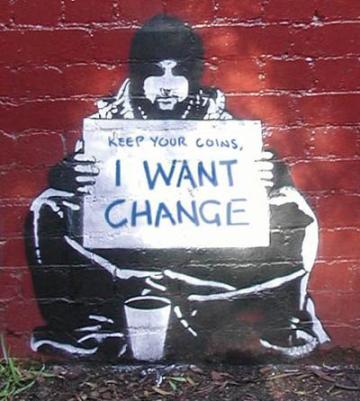By Leo Babauta
 One of the biggest frustrations many of us feel is having too much to do, and not feeling like we have enough time to do it. We are overwhelmed.
One of the biggest frustrations many of us feel is having too much to do, and not feeling like we have enough time to do it. We are overwhelmed.
Of course, having “not enough time” is just a feeling — we all have the same amount of time, but we often fill up the container of our days with too much stuff.
The problem is having too much stuff to fit into a small container (24 hours). If we look at task management and time management as simply a container organization problem, it becomes simpler.
How do we fit all of the stuff we have to do into our small container?
By simplifying.
And letting go.
I promise, with this two-step process, you’ll be able to deal with the problem of “too much to do, not enough time.”
Simplifying Our Tasks
When we realize we’re trying to fit too much stuff (tasks, errands, obligations) into a small container (24 hours), it becomes obvious that we can’t get a bigger container … so we have to get rid of some stuff. It just won’t all fit.
We do that by simplifying what we have to do.
Mindfulness is a helpful too here: pay attention to all the things you do today and tomorrow, and try to notice all the things you’re fitting into the container of your day. What websites are you going to in the morning? In the evening? What games are you playing on your phone? What are you reading? What busy-work are you doing? How much time are you spending in email, on Facebook, on Twitter, on Instagram? How much time on blogs, online shopping sites, Youtube? How much TV are you watching? How much time do you spend cleaning, maintaining your personal hygiene, taking care of other people? How much time driving around or commuting? What are you spending the valuable commodity of your attention on?
What you might realize is that you’re fitting a lot of junk into the container. Toss some of that out. Ban yourself from certain sites or apps until you’ve done a few really important tasks.
Notice also that you’re committed to a lot of things. Those commitments are filling up your life. Start getting out of some of them, and saying “no” to new ones.
Now look at your task list: how many of those things can you reasonably do today? I say three.
If you could only do three things today, which would be the most important? If you’ve ever played baseball, and swung a bat, you know that what matters is not so much how hard you swing, but hitting the ball with the sweet spot of the bat. What you need to do with your task list is hit it with the sweet spot of the bat — find the tasks that have the most impact, that matter most to your life. Choose carefully, because you only have so much room in your life.
Now ask yourself this: which task would you do if you could only do one task today? That should be what you put your focus on next. Just that one task. You can’t do your entire list today, and you can’t do your top three tasks right now. So just focus on one important task.
Clear everything else away, and focus on that.
By picking your tasks carefully, you’re taking care with the container of your time. You can pick important tasks or joyful ones, but you’re being conscious about the choices. You’re treating it like the precious gift that it is: limited, valuable, to be filled with the best things, and not overstuffed.
The Art of Letting Go
What about all the other stuff you want to do (or feel you need to do)? What if it doesn’t fit into the container?
This is where the joyful art of letting go becomes useful.
You have too many things to fit into your container, and you’ve decided to only put the important and beautiful things into the container. That means a bunch of things you think you “should” do are not going to fit.
You can get to those later. Or you can not do them. Either way, they won’t fit into today’s container.
This in itself is not a problem, but it only becomes a problem when you are frustrated that you can’t fit it all in. Your frustration comes from an ideal that you should be able to do it all, that you should be able to do everything on your list. Plus more: you want to travel, workout, meditate, learn a new skill, read more, be the perfect spouse (or find a spouse), be the perfect parent/friend/sibling, draw or create music, and so on.
Your ideals don’t match with reality — the reality is that you can’t do this all today, or even this week. You can choose to do some of them, but the others will have to wait, or not get done at all.
Since you can’t get a bigger container, you need to adjust your ideals. The ideal you choose to have can be this: that this moment be exactly as it is. The old ideal is one that you can toss into the ocean, as it was harming you (causing frustration). Let it go with joy and relief.
The new ideal is that this moment is perfect, and it deserves to be in your container.
Source: http://zenhabits.net/overloaded/


